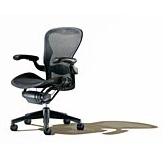Are you sitting down? Get ready for a chair that's good for your body


Fifteen years ago, Herman Miller introduced the Aeron, a chair so revolutionary that the Museum of Modern Art added it to its 20th Century Design Collection. But more importantly, the Aeron saved a lot of people—including me-- from back pain, by providing an ergonomically correct seat for our endless hours in front of the computer.
I recently talked to Jack Schreur, vice president of North American Seating for Herman Miller, which was named this year among Fast Company’s Most Innovative Companies.
Was it the Aeron that made people start thinking about ergonomics in office seating?
Ergonomic seating was developed in a meaningful way by Herman Miller and designer Bill Stumpf in the early ‘70s. A chair we called the Ergon came out in 1976, and that was the world’s first purposefully ergonomic chair. The idea that you have to pay attention to people’s bodies--and the way they work--was a new concept at the time. So the Aeron wasn’t the first, but it was the first that realized you could strip away all the padding and foam and provide a far higher level of comfort. Up until then, there was this idea that a chair’s comfort was connected to how much foam and leather was on it.
So this chair was a real game-changer.
It was pretty revolutionary. They are one of the best-selling chairs in the history of seating. I’m particularly proud of the way it has turned millions of ordinary people into folks who care about how they sit. Once these chairs get in the marketplace they stay there. Sometimes when people leave a job, they try to wheel their chairs out the door with them.
A chair like this allows us to sit for longer periods without discomfort, but being encouraged to work longer isn’t always a good thing, right? Americans already work pretty long hours.
I think the simple truth is that we’re going to be working longer whether we’re in a good chair or bad chair. So the right answer is to sit in a good chair and one that supports your spine. The idea that everybody deserves a good chair—an old slogan at Herman Miller—is still true today.
How do societal changes affect seating design?
Today, the growth of mobility in the workforce is the primary factor. More people are working outside the office—in collaborative spaces, conference rooms or Starbucks. Also, 15 years ago, our technology was so clumsy that you really had to array your work station and furniture around your technology. Today, we array our technology around us. We released the Setu chair last year (setu is the Hindi word for bridge). It came about because the designers in Berlin realized lots of people sit in places other than their dedicated office space, and most of the time it was in not-great chairs.
What do we have to look forward to in our seating?
We know sitting is bad for you, so we’ve spent the last 30 years trying to ameliorate that. The next generation of chairs will move beyond doing harm to your body and toward creating actively healthy sitting. The Embody chair increases blood flow and air intake, and that’s a big step. The next step is chairs that do those things in simple and elegant ways. The tilt kinematics will automatically sense and adjust for the user, so tilt tension adjustment and forward tilt will be automatic. We’ll get these instantly comfortable chairs without an awful lot of adjustment.
Related: TechRepublic Product Spotlight: Herman Miller Embody Chair
This post was originally published on Smartplanet.com